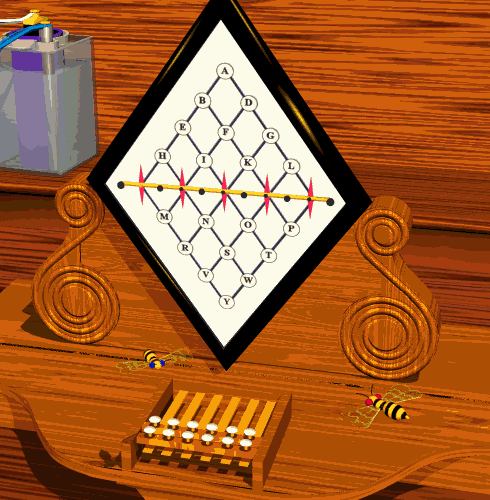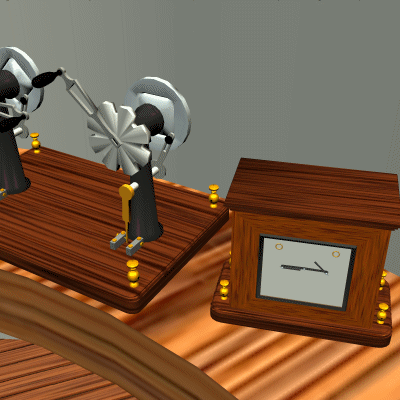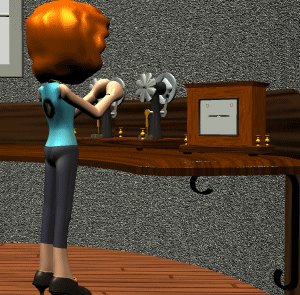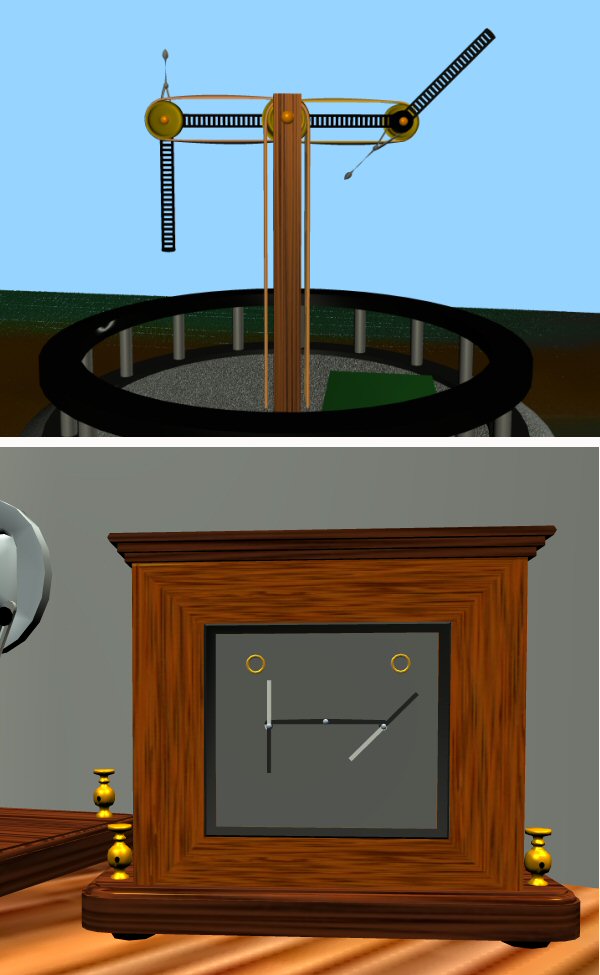Wednesday, July 08, 2020
Charge of the light Breguet
While trying to find a Breguet cryptograph I bumped into this device. This one machine connects up FOUR of my 'patient machine' sets. An amazingly cross-linked bridge, with a lesson for moderns. The important thing about this device is its HUMAN PURPOSE, not its mechanism.
Tracing the links:
Chappe's semaphore came first.
The 1793 revolutionaries picked up Chappe's visual system and built towers all across France. After the revolution morphed into Napoleon's neocon empire, the system expanded even more.
Around 1832 other countries started to experiment with electrical telegraphs of various forms. France didn't really need to get ahead of this trend, because the Chappe system was faster than the early electrics, and was already built and functioning smoothly. By 1845 the electrical systems had matured to the point where a switch was worth the trouble.
Wheatstone and Cooke offered to build a version of their system, but France rejected it. Wheatstone's setup was fast but delicate:
 and above all it was English.
The Breguet dial telegraph was French, and it was especially suitable for unskilled operators.
and above all it was English.
The Breguet dial telegraph was French, and it was especially suitable for unskilled operators.
 Breguet was unsurprisingly clock-like. Turning the sender dial to the next character clicked a contactor back and forth, sending pulses to the receiver. When the receiver was pulsed, a solenoid opened an escapement and allowed the dial to turn forward by one letter.
France used Breguet for its railroads, which weren't already equipped with a functional signaling system and trained operators. The Breguet dial didn't require new learning.
To replace the Chappe visual system for their State Telegraph, France made a unique move.
Breguet was unsurprisingly clock-like. Turning the sender dial to the next character clicked a contactor back and forth, sending pulses to the receiver. When the receiver was pulsed, a solenoid opened an escapement and allowed the dial to turn forward by one letter.
France used Breguet for its railroads, which weren't already equipped with a functional signaling system and trained operators. The Breguet dial didn't require new learning.
To replace the Chappe visual system for their State Telegraph, France made a unique move.
 They developed an electrical version of the mechanical Chappe system, based internally on the same principle as the Breguet dial.
They developed an electrical version of the mechanical Chappe system, based internally on the same principle as the Breguet dial.
 The mechanical Chappe had two movable wings on a movable center wing. All three rotated to form 256 possible codes. As the system matured, most of those codes were used efficiently for phrases and words, so the sending was much faster than letter-by-letter.
From Lardner's 1855 book:
The mechanical Chappe had two movable wings on a movable center wing. All three rotated to form 256 possible codes. As the system matured, most of those codes were used efficiently for phrases and words, so the sending was much faster than letter-by-letter.
From Lardner's 1855 book:
 You can see how the crank moved the contactor back and forth with a cam. The contactor looked like an SPDT switch, but it was actually a two-way SPST. Each side sent a single pulse through the long lines to the receiver, so one revolution sent 8 pulses.
In action, the operator turned the cranks to form each letter, always clockwise. The operator could see the result on her own receiver, or receive signals from other stations.
You can see how the crank moved the contactor back and forth with a cam. The contactor looked like an SPDT switch, but it was actually a two-way SPST. Each side sent a single pulse through the long lines to the receiver, so one revolution sent 8 pulses.
In action, the operator turned the cranks to form each letter, always clockwise. The operator could see the result on her own receiver, or receive signals from other stations.
 'Video' displays were common in railroad signal systems, like the splendid Train Describer used in both US and UK. This was a combination of Breguet sender and Wheatstonish display, somewhat like the Foy.
= = = = =
One of the British books on telegraphy has an intriguing picture of an all-in-one Foy-Breguet device, with no accompanying description.
'Video' displays were common in railroad signal systems, like the splendid Train Describer used in both US and UK. This was a combination of Breguet sender and Wheatstonish display, somewhat like the Foy.
= = = = =
One of the British books on telegraphy has an intriguing picture of an all-in-one Foy-Breguet device, with no accompanying description.
 This has the receiver screen, plus two separate pairs of senders, plus a single crank (probably a receive/send/both switch), plus a mysterious snowglobe and two whistles on top! I'll keep watching for more info on this one. It's pure steampunk.
= = = = =
Above all, the Foy-Breguet system PRESERVED SKILL-ESTATE. Foy RE-USED the skills acquired by the Chappe semaphore operators, so they wouldn't be obsolesced by the switch to electricity.
The cranks were similar to the Chappe cranks, and even the little mini-wings were similar to the real wings.
This has the receiver screen, plus two separate pairs of senders, plus a single crank (probably a receive/send/both switch), plus a mysterious snowglobe and two whistles on top! I'll keep watching for more info on this one. It's pure steampunk.
= = = = =
Above all, the Foy-Breguet system PRESERVED SKILL-ESTATE. Foy RE-USED the skills acquired by the Chappe semaphore operators, so they wouldn't be obsolesced by the switch to electricity.
The cranks were similar to the Chappe cranks, and even the little mini-wings were similar to the real wings.
 Since they were basically clock hands, they didn't need to be balanced levers pivoted at the center; but they were built that way, with a black 'visible' part and a white 'counterweight' part.
= = = = =
France learned a major lesson from the 1793 revolution. After the EXTREME dose of Innovative Disruption in every aspect of life, the French became the world's best PRESERVERS. They tried to maintain everyday objects and skills instead of discarding them. The tendency was still strong in the 1970s; I don't know if it's still strong now. Unions are certainly strong.
Wars and revolutions and depressions often induce this healthy immune response. America was in skill-preservation mode after the 1930s depression, thanks to FDR's emphasis on work and training and unions. We remained in skill-estate mode until the '70s when Nixon, then Reagan, then Clinton, cumulatively removed ALL the supporting framework and shipped ALL skills overseas.
There's already some indication that the current holocaust is inducing a healthy PRESERVATION impulse for money. Wolfstreet noted a decrease in credit card usage and increase in savings. Bloomberg sees "a new austerity, expressed through pantry stockpiling and delayed big-ticket purchases."
We also need to follow the French model of frugality in skills and knowledge. The long-term goal of globalism is to eliminate all skills and knowledge, and the current holocaust is an EXTREME FINAL step in this process. Jobs requiring skill are "non-essential", and all knowledge of science and logic and truth has been precisely and diametrically inverted and garbled and deleted.
We've got a partial start through Emerson justice. Public schools and major colleges have voluntarily committed suicide "because virus", thus eliminating the main purveyors of ANTI-SKILL education. The field is open for smart operators like DeVry. Will they step up and take advantage?
Probably not. We don't have FDR or Harding at the top to break the litigation and regulation obstacles. Instead we have Trump, Deepstate's most loyal and perfect servant. FDR locked down the banks to enrich the real economy. Trump locked down the real economy to enrich the banks.
The overriding perpetual purpose of the 'enlightenment', from 1776 to 1793 to now, is to obliterate PURPOSE from life. The focus on "rights" instead of duties started the breakdown. The focus on finance and abstraction instead of industry finished it.
Natural Law in its varied forms, whether the Sharia rules or the Soviet Constitution or FDR's four freedoms, always starts with PURPOSE AND WORK. Every aspect of the economy and culture is shaped to preserve PURPOSE for ordinary people. The 'enlightenment' starts with "rights" and "freedom", which means that psychopaths are free to dominate culture and economy, free to eliminate all PURPOSE from ordinary workers and families. The sole PURPOSE of a psychopath is to obliterate PURPOSE.
LIFE IS PURPOSE.
= = = = =
Literary footnote: The Lardner book is OUTSTANDING. Bear in mind that he was writing in 1855, when the telegraph and railroads were pretty much the only modern tech. The telephone and phonograph were 20 years in the future, and everything else at least 40 years away. He explains both the tech side and the business side with absolute clarity and completeness. Several times I've tried without luck to figure out how something was supposed to work, and Lardner clarified it totally.
Since they were basically clock hands, they didn't need to be balanced levers pivoted at the center; but they were built that way, with a black 'visible' part and a white 'counterweight' part.
= = = = =
France learned a major lesson from the 1793 revolution. After the EXTREME dose of Innovative Disruption in every aspect of life, the French became the world's best PRESERVERS. They tried to maintain everyday objects and skills instead of discarding them. The tendency was still strong in the 1970s; I don't know if it's still strong now. Unions are certainly strong.
Wars and revolutions and depressions often induce this healthy immune response. America was in skill-preservation mode after the 1930s depression, thanks to FDR's emphasis on work and training and unions. We remained in skill-estate mode until the '70s when Nixon, then Reagan, then Clinton, cumulatively removed ALL the supporting framework and shipped ALL skills overseas.
There's already some indication that the current holocaust is inducing a healthy PRESERVATION impulse for money. Wolfstreet noted a decrease in credit card usage and increase in savings. Bloomberg sees "a new austerity, expressed through pantry stockpiling and delayed big-ticket purchases."
We also need to follow the French model of frugality in skills and knowledge. The long-term goal of globalism is to eliminate all skills and knowledge, and the current holocaust is an EXTREME FINAL step in this process. Jobs requiring skill are "non-essential", and all knowledge of science and logic and truth has been precisely and diametrically inverted and garbled and deleted.
We've got a partial start through Emerson justice. Public schools and major colleges have voluntarily committed suicide "because virus", thus eliminating the main purveyors of ANTI-SKILL education. The field is open for smart operators like DeVry. Will they step up and take advantage?
Probably not. We don't have FDR or Harding at the top to break the litigation and regulation obstacles. Instead we have Trump, Deepstate's most loyal and perfect servant. FDR locked down the banks to enrich the real economy. Trump locked down the real economy to enrich the banks.
The overriding perpetual purpose of the 'enlightenment', from 1776 to 1793 to now, is to obliterate PURPOSE from life. The focus on "rights" instead of duties started the breakdown. The focus on finance and abstraction instead of industry finished it.
Natural Law in its varied forms, whether the Sharia rules or the Soviet Constitution or FDR's four freedoms, always starts with PURPOSE AND WORK. Every aspect of the economy and culture is shaped to preserve PURPOSE for ordinary people. The 'enlightenment' starts with "rights" and "freedom", which means that psychopaths are free to dominate culture and economy, free to eliminate all PURPOSE from ordinary workers and families. The sole PURPOSE of a psychopath is to obliterate PURPOSE.
LIFE IS PURPOSE.
= = = = =
Literary footnote: The Lardner book is OUTSTANDING. Bear in mind that he was writing in 1855, when the telegraph and railroads were pretty much the only modern tech. The telephone and phonograph were 20 years in the future, and everything else at least 40 years away. He explains both the tech side and the business side with absolute clarity and completeness. Several times I've tried without luck to figure out how something was supposed to work, and Lardner clarified it totally.
 and above all it was English.
The Breguet dial telegraph was French, and it was especially suitable for unskilled operators.
and above all it was English.
The Breguet dial telegraph was French, and it was especially suitable for unskilled operators.
 Breguet was unsurprisingly clock-like. Turning the sender dial to the next character clicked a contactor back and forth, sending pulses to the receiver. When the receiver was pulsed, a solenoid opened an escapement and allowed the dial to turn forward by one letter.
France used Breguet for its railroads, which weren't already equipped with a functional signaling system and trained operators. The Breguet dial didn't require new learning.
To replace the Chappe visual system for their State Telegraph, France made a unique move.
Breguet was unsurprisingly clock-like. Turning the sender dial to the next character clicked a contactor back and forth, sending pulses to the receiver. When the receiver was pulsed, a solenoid opened an escapement and allowed the dial to turn forward by one letter.
France used Breguet for its railroads, which weren't already equipped with a functional signaling system and trained operators. The Breguet dial didn't require new learning.
To replace the Chappe visual system for their State Telegraph, France made a unique move.
 They developed an electrical version of the mechanical Chappe system, based internally on the same principle as the Breguet dial.
They developed an electrical version of the mechanical Chappe system, based internally on the same principle as the Breguet dial.
 The mechanical Chappe had two movable wings on a movable center wing. All three rotated to form 256 possible codes. As the system matured, most of those codes were used efficiently for phrases and words, so the sending was much faster than letter-by-letter.
From Lardner's 1855 book:
The mechanical Chappe had two movable wings on a movable center wing. All three rotated to form 256 possible codes. As the system matured, most of those codes were used efficiently for phrases and words, so the sending was much faster than letter-by-letter.
From Lardner's 1855 book:
When the establishment of lines of electric telegraphs was proposed in France, the old aerial telegraph was, and had been for more than half a century, in operation, and formed a department in the public administration of considerable importance, employing an extensive body of agents, dispersed throughout the country, most of whom were specially instructed and qualified for the business. The commission appointed by the government required that the electro-telegraphic instruments should exhibit the same signals as had been already used in the case of the former telegraph.This setup is generally known as the Foy-Breguet system. The sender has two cranks just like Chappe, and the receiver is a miniature 'video display' of two wings just like Chappe.
 You can see how the crank moved the contactor back and forth with a cam. The contactor looked like an SPDT switch, but it was actually a two-way SPST. Each side sent a single pulse through the long lines to the receiver, so one revolution sent 8 pulses.
In action, the operator turned the cranks to form each letter, always clockwise. The operator could see the result on her own receiver, or receive signals from other stations.
You can see how the crank moved the contactor back and forth with a cam. The contactor looked like an SPDT switch, but it was actually a two-way SPST. Each side sent a single pulse through the long lines to the receiver, so one revolution sent 8 pulses.
In action, the operator turned the cranks to form each letter, always clockwise. The operator could see the result on her own receiver, or receive signals from other stations.
 'Video' displays were common in railroad signal systems, like the splendid Train Describer used in both US and UK. This was a combination of Breguet sender and Wheatstonish display, somewhat like the Foy.
= = = = =
One of the British books on telegraphy has an intriguing picture of an all-in-one Foy-Breguet device, with no accompanying description.
'Video' displays were common in railroad signal systems, like the splendid Train Describer used in both US and UK. This was a combination of Breguet sender and Wheatstonish display, somewhat like the Foy.
= = = = =
One of the British books on telegraphy has an intriguing picture of an all-in-one Foy-Breguet device, with no accompanying description.
 This has the receiver screen, plus two separate pairs of senders, plus a single crank (probably a receive/send/both switch), plus a mysterious snowglobe and two whistles on top! I'll keep watching for more info on this one. It's pure steampunk.
= = = = =
Above all, the Foy-Breguet system PRESERVED SKILL-ESTATE. Foy RE-USED the skills acquired by the Chappe semaphore operators, so they wouldn't be obsolesced by the switch to electricity.
The cranks were similar to the Chappe cranks, and even the little mini-wings were similar to the real wings.
This has the receiver screen, plus two separate pairs of senders, plus a single crank (probably a receive/send/both switch), plus a mysterious snowglobe and two whistles on top! I'll keep watching for more info on this one. It's pure steampunk.
= = = = =
Above all, the Foy-Breguet system PRESERVED SKILL-ESTATE. Foy RE-USED the skills acquired by the Chappe semaphore operators, so they wouldn't be obsolesced by the switch to electricity.
The cranks were similar to the Chappe cranks, and even the little mini-wings were similar to the real wings.
 Since they were basically clock hands, they didn't need to be balanced levers pivoted at the center; but they were built that way, with a black 'visible' part and a white 'counterweight' part.
= = = = =
France learned a major lesson from the 1793 revolution. After the EXTREME dose of Innovative Disruption in every aspect of life, the French became the world's best PRESERVERS. They tried to maintain everyday objects and skills instead of discarding them. The tendency was still strong in the 1970s; I don't know if it's still strong now. Unions are certainly strong.
Wars and revolutions and depressions often induce this healthy immune response. America was in skill-preservation mode after the 1930s depression, thanks to FDR's emphasis on work and training and unions. We remained in skill-estate mode until the '70s when Nixon, then Reagan, then Clinton, cumulatively removed ALL the supporting framework and shipped ALL skills overseas.
There's already some indication that the current holocaust is inducing a healthy PRESERVATION impulse for money. Wolfstreet noted a decrease in credit card usage and increase in savings. Bloomberg sees "a new austerity, expressed through pantry stockpiling and delayed big-ticket purchases."
We also need to follow the French model of frugality in skills and knowledge. The long-term goal of globalism is to eliminate all skills and knowledge, and the current holocaust is an EXTREME FINAL step in this process. Jobs requiring skill are "non-essential", and all knowledge of science and logic and truth has been precisely and diametrically inverted and garbled and deleted.
We've got a partial start through Emerson justice. Public schools and major colleges have voluntarily committed suicide "because virus", thus eliminating the main purveyors of ANTI-SKILL education. The field is open for smart operators like DeVry. Will they step up and take advantage?
Probably not. We don't have FDR or Harding at the top to break the litigation and regulation obstacles. Instead we have Trump, Deepstate's most loyal and perfect servant. FDR locked down the banks to enrich the real economy. Trump locked down the real economy to enrich the banks.
The overriding perpetual purpose of the 'enlightenment', from 1776 to 1793 to now, is to obliterate PURPOSE from life. The focus on "rights" instead of duties started the breakdown. The focus on finance and abstraction instead of industry finished it.
Natural Law in its varied forms, whether the Sharia rules or the Soviet Constitution or FDR's four freedoms, always starts with PURPOSE AND WORK. Every aspect of the economy and culture is shaped to preserve PURPOSE for ordinary people. The 'enlightenment' starts with "rights" and "freedom", which means that psychopaths are free to dominate culture and economy, free to eliminate all PURPOSE from ordinary workers and families. The sole PURPOSE of a psychopath is to obliterate PURPOSE.
LIFE IS PURPOSE.
= = = = =
Literary footnote: The Lardner book is OUTSTANDING. Bear in mind that he was writing in 1855, when the telegraph and railroads were pretty much the only modern tech. The telephone and phonograph were 20 years in the future, and everything else at least 40 years away. He explains both the tech side and the business side with absolute clarity and completeness. Several times I've tried without luck to figure out how something was supposed to work, and Lardner clarified it totally.
Since they were basically clock hands, they didn't need to be balanced levers pivoted at the center; but they were built that way, with a black 'visible' part and a white 'counterweight' part.
= = = = =
France learned a major lesson from the 1793 revolution. After the EXTREME dose of Innovative Disruption in every aspect of life, the French became the world's best PRESERVERS. They tried to maintain everyday objects and skills instead of discarding them. The tendency was still strong in the 1970s; I don't know if it's still strong now. Unions are certainly strong.
Wars and revolutions and depressions often induce this healthy immune response. America was in skill-preservation mode after the 1930s depression, thanks to FDR's emphasis on work and training and unions. We remained in skill-estate mode until the '70s when Nixon, then Reagan, then Clinton, cumulatively removed ALL the supporting framework and shipped ALL skills overseas.
There's already some indication that the current holocaust is inducing a healthy PRESERVATION impulse for money. Wolfstreet noted a decrease in credit card usage and increase in savings. Bloomberg sees "a new austerity, expressed through pantry stockpiling and delayed big-ticket purchases."
We also need to follow the French model of frugality in skills and knowledge. The long-term goal of globalism is to eliminate all skills and knowledge, and the current holocaust is an EXTREME FINAL step in this process. Jobs requiring skill are "non-essential", and all knowledge of science and logic and truth has been precisely and diametrically inverted and garbled and deleted.
We've got a partial start through Emerson justice. Public schools and major colleges have voluntarily committed suicide "because virus", thus eliminating the main purveyors of ANTI-SKILL education. The field is open for smart operators like DeVry. Will they step up and take advantage?
Probably not. We don't have FDR or Harding at the top to break the litigation and regulation obstacles. Instead we have Trump, Deepstate's most loyal and perfect servant. FDR locked down the banks to enrich the real economy. Trump locked down the real economy to enrich the banks.
The overriding perpetual purpose of the 'enlightenment', from 1776 to 1793 to now, is to obliterate PURPOSE from life. The focus on "rights" instead of duties started the breakdown. The focus on finance and abstraction instead of industry finished it.
Natural Law in its varied forms, whether the Sharia rules or the Soviet Constitution or FDR's four freedoms, always starts with PURPOSE AND WORK. Every aspect of the economy and culture is shaped to preserve PURPOSE for ordinary people. The 'enlightenment' starts with "rights" and "freedom", which means that psychopaths are free to dominate culture and economy, free to eliminate all PURPOSE from ordinary workers and families. The sole PURPOSE of a psychopath is to obliterate PURPOSE.
LIFE IS PURPOSE.
= = = = =
Literary footnote: The Lardner book is OUTSTANDING. Bear in mind that he was writing in 1855, when the telegraph and railroads were pretty much the only modern tech. The telephone and phonograph were 20 years in the future, and everything else at least 40 years away. He explains both the tech side and the business side with absolute clarity and completeness. Several times I've tried without luck to figure out how something was supposed to work, and Lardner clarified it totally.Labels: From rights to duties, Make or break, Morsenet of Things, skill-estate, storage
